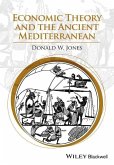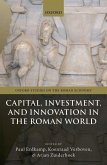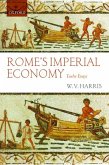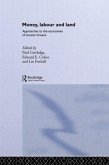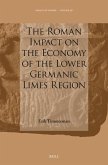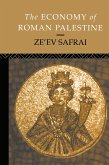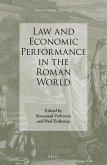- Gebundenes Buch
- Merkliste
- Auf die Merkliste
- Bewerten Bewerten
- Teilen
- Produkt teilen
- Produkterinnerung
- Produkterinnerung
The Roman conquest of Italy in the Republican period led to widespread economic changes in which the conquered Italians played an important role. This volume explores the interplay between economic activities and the integration of the Italian peoples into the Roman civic, legal, social, and cultural framework.
Andere Kunden interessierten sich auch für
![Economic Theory and the Ancient Mediterranean Economic Theory and the Ancient Mediterranean]() Donald W. JonesEconomic Theory and the Ancient Mediterranean247,99 €
Donald W. JonesEconomic Theory and the Ancient Mediterranean247,99 €![Capital, Investment, and Innovation in the Roman World Capital, Investment, and Innovation in the Roman World]() Capital, Investment, and Innovation in the Roman World206,99 €
Capital, Investment, and Innovation in the Roman World206,99 €![Rome's Imperial Economy Rome's Imperial Economy]() W V HarrisRome's Imperial Economy258,99 €
W V HarrisRome's Imperial Economy258,99 €![Money, Labour and Land Money, Labour and Land]() Paul Cartledge / Edward E. Cohen (eds.)Money, Labour and Land202,99 €
Paul Cartledge / Edward E. Cohen (eds.)Money, Labour and Land202,99 €![The Roman Impact on the Economy of the Lower Germanic Limes Region The Roman Impact on the Economy of the Lower Germanic Limes Region]() Erik TimmermanThe Roman Impact on the Economy of the Lower Germanic Limes Region176,99 €
Erik TimmermanThe Roman Impact on the Economy of the Lower Germanic Limes Region176,99 €![The Economy of Roman Palestine The Economy of Roman Palestine]() Ze'Ev SafraiThe Economy of Roman Palestine202,99 €
Ze'Ev SafraiThe Economy of Roman Palestine202,99 €![Law and Economic Performance in the Roman World Law and Economic Performance in the Roman World]() Law and Economic Performance in the Roman World171,99 €
Law and Economic Performance in the Roman World171,99 €-
-
-
The Roman conquest of Italy in the Republican period led to widespread economic changes in which the conquered Italians played an important role. This volume explores the interplay between economic activities and the integration of the Italian peoples into the Roman civic, legal, social, and cultural framework.
Hinweis: Dieser Artikel kann nur an eine deutsche Lieferadresse ausgeliefert werden.
Hinweis: Dieser Artikel kann nur an eine deutsche Lieferadresse ausgeliefert werden.
Produktdetails
- Produktdetails
- Verlag: Oxford University Press (UK)
- Seitenzahl: 314
- Erscheinungstermin: 19. November 2019
- Englisch
- Abmessung: 243mm x 167mm x 27mm
- Gewicht: 641g
- ISBN-13: 9780198829447
- ISBN-10: 0198829442
- Artikelnr.: 56973731
- Herstellerkennzeichnung
- Libri GmbH
- Europaallee 1
- 36244 Bad Hersfeld
- 06621 890
- Verlag: Oxford University Press (UK)
- Seitenzahl: 314
- Erscheinungstermin: 19. November 2019
- Englisch
- Abmessung: 243mm x 167mm x 27mm
- Gewicht: 641g
- ISBN-13: 9780198829447
- ISBN-10: 0198829442
- Artikelnr.: 56973731
- Herstellerkennzeichnung
- Libri GmbH
- Europaallee 1
- 36244 Bad Hersfeld
- 06621 890
Saskia T. Roselaar obtained her PhD from Leiden University in 2009 and has worked as a Newton International Fellow at the University of Manchester and as a Nottingham Advanced Research Fellow. Her 2010 book Public Land in the Roman Republic: A Social and Economic History of Ager Publicus in Italy, 396-89 BC (Oxford University Press) was awarded the James Henry Breasted Prize and the Premio Speciale della Corte Costituzionale della Repubblica Italiana. Her research interests cover the social, economic, and legal history of the Roman Republic, as well as issues of citizenship and integration in the Roman world in general.
* Frontmatter
* List of Figures
* List of Maps
* 1: Introduction: economy and integration in the Roman Republic
* 1.1: Introduction
* 1.2: The structure of this book
* 1.3: Economic activities and institutions
* 1.4: Integration and identity
* 1.5: Integration and Romanization
* 1.6: The administration of conquered areas
* 1.7: Sources and methodology
* 2: Points of contact: interaction between Roman and Italian
* 2.1: Introduction
* 2.2: Roman colonization and spatial integration between Romans and
Italians
* 2.3: Migration and mobility
* 2.4: Sanctuaries and temples as meeting places
* 2.5: Fairs and markets
* 2.6: Other interactions between Romans and Italians
* 2.6.1: Military service
* 2.6.2: Social relations: intermarriage, friendships, elite networks
* 2.7: Conclusion
* 3: The economic integration of Italy
* 3.1: Introduction
* 3.2: Italian commercial activities in the Mediterranean
* 3.2.1: Italians in the Mediterranean
* 3.2.2: Commercial export
* 3.2.3: Developments in agriculture and manufacturing
* 3.3: Economic developments in Italy
* 3.3.1: Latium
* 3.3.2: Campania
* 3.3.3: Apulia
* 3.3.4: Lucania and Bruttium
* 3.3.5: Macroeconomic developments in Republican Italy
* 3.4: Conclusion
* 4: Consequences of interaction: institutional and cultural change
* 4.1: Introduction
* 4.2: Legal and institutional instruments for interaction
* 4.2.1: Legal developments
* 4.2.2: Italian administration and institutions
* 4.2.3: Italian and Roman coinage
* 4.2.4: Weights and measures
* 4.2.5: Conclusion
* 4.3: The investment of wealth in Italy
* 4.4: Cultural developments
* 4.5: Linguistic developments
* 4.6: The concept of Italian and Italian identity
* 4.7: Roman protection of its allies
* 4.8: Conclusion
* 5: From economic to political integration
* 5.1: Introduction
* 5.2: Cultural prejudice against Italians
* 5.3: The position of Italians in the late second century
* 5.3.1: Roman and Italian power relations
* 5.3.2: Lack of Roman citizenship and its negative effects for
economic activities
* 5.3.3: Other causes of resentment
* 5.4: Demands for citizenship in the late second century
* 5.5: The outbreak of the Social War
* 5.6: The grant of citizenship to the Italians
* 5.7: Political and economic opportunities for Italians after the
Social War
* 5.8: Italian identity after the Social War
* 5.9: Conclusion
* 6: General conclusions
* Endmatter
* Bibliography
* Index
* List of Figures
* List of Maps
* 1: Introduction: economy and integration in the Roman Republic
* 1.1: Introduction
* 1.2: The structure of this book
* 1.3: Economic activities and institutions
* 1.4: Integration and identity
* 1.5: Integration and Romanization
* 1.6: The administration of conquered areas
* 1.7: Sources and methodology
* 2: Points of contact: interaction between Roman and Italian
* 2.1: Introduction
* 2.2: Roman colonization and spatial integration between Romans and
Italians
* 2.3: Migration and mobility
* 2.4: Sanctuaries and temples as meeting places
* 2.5: Fairs and markets
* 2.6: Other interactions between Romans and Italians
* 2.6.1: Military service
* 2.6.2: Social relations: intermarriage, friendships, elite networks
* 2.7: Conclusion
* 3: The economic integration of Italy
* 3.1: Introduction
* 3.2: Italian commercial activities in the Mediterranean
* 3.2.1: Italians in the Mediterranean
* 3.2.2: Commercial export
* 3.2.3: Developments in agriculture and manufacturing
* 3.3: Economic developments in Italy
* 3.3.1: Latium
* 3.3.2: Campania
* 3.3.3: Apulia
* 3.3.4: Lucania and Bruttium
* 3.3.5: Macroeconomic developments in Republican Italy
* 3.4: Conclusion
* 4: Consequences of interaction: institutional and cultural change
* 4.1: Introduction
* 4.2: Legal and institutional instruments for interaction
* 4.2.1: Legal developments
* 4.2.2: Italian administration and institutions
* 4.2.3: Italian and Roman coinage
* 4.2.4: Weights and measures
* 4.2.5: Conclusion
* 4.3: The investment of wealth in Italy
* 4.4: Cultural developments
* 4.5: Linguistic developments
* 4.6: The concept of Italian and Italian identity
* 4.7: Roman protection of its allies
* 4.8: Conclusion
* 5: From economic to political integration
* 5.1: Introduction
* 5.2: Cultural prejudice against Italians
* 5.3: The position of Italians in the late second century
* 5.3.1: Roman and Italian power relations
* 5.3.2: Lack of Roman citizenship and its negative effects for
economic activities
* 5.3.3: Other causes of resentment
* 5.4: Demands for citizenship in the late second century
* 5.5: The outbreak of the Social War
* 5.6: The grant of citizenship to the Italians
* 5.7: Political and economic opportunities for Italians after the
Social War
* 5.8: Italian identity after the Social War
* 5.9: Conclusion
* 6: General conclusions
* Endmatter
* Bibliography
* Index
* Frontmatter
* List of Figures
* List of Maps
* 1: Introduction: economy and integration in the Roman Republic
* 1.1: Introduction
* 1.2: The structure of this book
* 1.3: Economic activities and institutions
* 1.4: Integration and identity
* 1.5: Integration and Romanization
* 1.6: The administration of conquered areas
* 1.7: Sources and methodology
* 2: Points of contact: interaction between Roman and Italian
* 2.1: Introduction
* 2.2: Roman colonization and spatial integration between Romans and
Italians
* 2.3: Migration and mobility
* 2.4: Sanctuaries and temples as meeting places
* 2.5: Fairs and markets
* 2.6: Other interactions between Romans and Italians
* 2.6.1: Military service
* 2.6.2: Social relations: intermarriage, friendships, elite networks
* 2.7: Conclusion
* 3: The economic integration of Italy
* 3.1: Introduction
* 3.2: Italian commercial activities in the Mediterranean
* 3.2.1: Italians in the Mediterranean
* 3.2.2: Commercial export
* 3.2.3: Developments in agriculture and manufacturing
* 3.3: Economic developments in Italy
* 3.3.1: Latium
* 3.3.2: Campania
* 3.3.3: Apulia
* 3.3.4: Lucania and Bruttium
* 3.3.5: Macroeconomic developments in Republican Italy
* 3.4: Conclusion
* 4: Consequences of interaction: institutional and cultural change
* 4.1: Introduction
* 4.2: Legal and institutional instruments for interaction
* 4.2.1: Legal developments
* 4.2.2: Italian administration and institutions
* 4.2.3: Italian and Roman coinage
* 4.2.4: Weights and measures
* 4.2.5: Conclusion
* 4.3: The investment of wealth in Italy
* 4.4: Cultural developments
* 4.5: Linguistic developments
* 4.6: The concept of Italian and Italian identity
* 4.7: Roman protection of its allies
* 4.8: Conclusion
* 5: From economic to political integration
* 5.1: Introduction
* 5.2: Cultural prejudice against Italians
* 5.3: The position of Italians in the late second century
* 5.3.1: Roman and Italian power relations
* 5.3.2: Lack of Roman citizenship and its negative effects for
economic activities
* 5.3.3: Other causes of resentment
* 5.4: Demands for citizenship in the late second century
* 5.5: The outbreak of the Social War
* 5.6: The grant of citizenship to the Italians
* 5.7: Political and economic opportunities for Italians after the
Social War
* 5.8: Italian identity after the Social War
* 5.9: Conclusion
* 6: General conclusions
* Endmatter
* Bibliography
* Index
* List of Figures
* List of Maps
* 1: Introduction: economy and integration in the Roman Republic
* 1.1: Introduction
* 1.2: The structure of this book
* 1.3: Economic activities and institutions
* 1.4: Integration and identity
* 1.5: Integration and Romanization
* 1.6: The administration of conquered areas
* 1.7: Sources and methodology
* 2: Points of contact: interaction between Roman and Italian
* 2.1: Introduction
* 2.2: Roman colonization and spatial integration between Romans and
Italians
* 2.3: Migration and mobility
* 2.4: Sanctuaries and temples as meeting places
* 2.5: Fairs and markets
* 2.6: Other interactions between Romans and Italians
* 2.6.1: Military service
* 2.6.2: Social relations: intermarriage, friendships, elite networks
* 2.7: Conclusion
* 3: The economic integration of Italy
* 3.1: Introduction
* 3.2: Italian commercial activities in the Mediterranean
* 3.2.1: Italians in the Mediterranean
* 3.2.2: Commercial export
* 3.2.3: Developments in agriculture and manufacturing
* 3.3: Economic developments in Italy
* 3.3.1: Latium
* 3.3.2: Campania
* 3.3.3: Apulia
* 3.3.4: Lucania and Bruttium
* 3.3.5: Macroeconomic developments in Republican Italy
* 3.4: Conclusion
* 4: Consequences of interaction: institutional and cultural change
* 4.1: Introduction
* 4.2: Legal and institutional instruments for interaction
* 4.2.1: Legal developments
* 4.2.2: Italian administration and institutions
* 4.2.3: Italian and Roman coinage
* 4.2.4: Weights and measures
* 4.2.5: Conclusion
* 4.3: The investment of wealth in Italy
* 4.4: Cultural developments
* 4.5: Linguistic developments
* 4.6: The concept of Italian and Italian identity
* 4.7: Roman protection of its allies
* 4.8: Conclusion
* 5: From economic to political integration
* 5.1: Introduction
* 5.2: Cultural prejudice against Italians
* 5.3: The position of Italians in the late second century
* 5.3.1: Roman and Italian power relations
* 5.3.2: Lack of Roman citizenship and its negative effects for
economic activities
* 5.3.3: Other causes of resentment
* 5.4: Demands for citizenship in the late second century
* 5.5: The outbreak of the Social War
* 5.6: The grant of citizenship to the Italians
* 5.7: Political and economic opportunities for Italians after the
Social War
* 5.8: Italian identity after the Social War
* 5.9: Conclusion
* 6: General conclusions
* Endmatter
* Bibliography
* Index


